
Chapter 2: Vectors
2.0. Overview
Vectors are quantities that have both a magnitude and a direction. Quantities that can be expressed as vectors include velocity, acceleration, displacement, force, momentum, electric field, magnetic field,...
We'll be using vectors throughout this course, so having a solid grasp of the fundamentals is critical.
Let's go!
- Vector Definition
- Graphical Analysis
- Adding and Subtracting Vectors
- Polar Notation of Vectors
- Unit Vectors (i, j)
2.1. Vector Definition
Some measurements—scalar quantities—are indicated by simply a number (and a unit): the height of a playing card (in inches? or centimeters?), the mass of penny (in grams, perhaps), the age of a person (in years, possibly).
But some measurements are vectors. Vectors have two characteristics: magnitude (the numeric part of the measurement), and direction (the orientation of the vector); and we’ve talked about three kinds of vector quantities so far:
- displacement x
- velocity v
- acceleration a
Up till now, we’ve considered very simple straight line motion, restricting ourselves to one-dimensional horizontal motion (in the +x or -x direction), or vertical motion (in the +y or -y direction). We need to expand our abilities now into additional dimensions.
Is temperature a vector?
One person claims that temperature is a scalar quantity, a number without direction that indicates how hot or cold something is.
Another person suggests that temperature is a vector quantity that can go up (positive values) or down (on into negative values even), just as a displacement or velocity can go up or down.
Is temperature a scalar or a vector?
Answer:
Temperature is a scalar quantity.
In physics, a vector is a value that points in a given direction in space. (There are other definitions for a vector in math and computer science.) While temperatures do have positive or negative values relative to some zero-point, this does not indicate a direction in space.
2.2. Graphical Analysis
One way of analyzing 2-dimensional situations with vectors is by drawing the vector on paper, according to the following rules.
- the length of a line drawn is proportional to the magnitude of the vector quantity
- the direction that the arrow points (relative to an Cartesian coordinate system) indicates the direction of vector quantity
The following diagrams illustrate vectors that indicate various quantities.
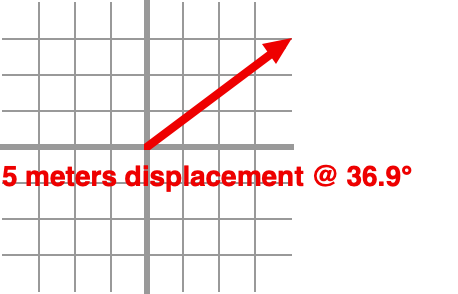
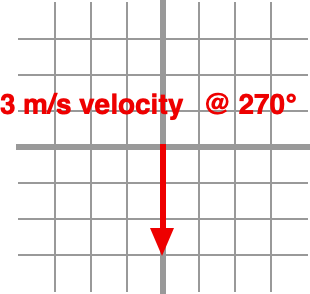
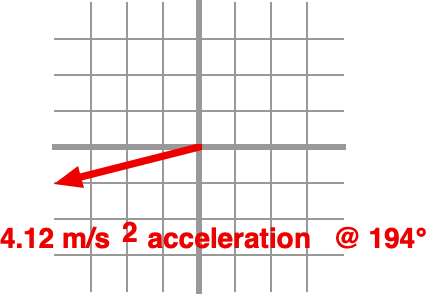
How to indicate direction?
Note that angle measures are given relative to 0° along the positive x-axis, with positive angles going counter-clockwise around the origin.
There are other ways to indicate direction, but this is the best way, and the one you should use in describing the direction of a vector quantity.
2.3. Adding and Subtracting Vectors
It turns out that there are lots of things we can use vectors for: adding vectors, for example, allows us to determine the combined effects of two different motions. A plane flying north in air that is being blown to the west, for example, will have a direction relative to the earth that is not directly north.
Throughout this course we will be drawing diagrams to represent situations, and this includes working with vectors.
2.3.1. Adding vectors graphically
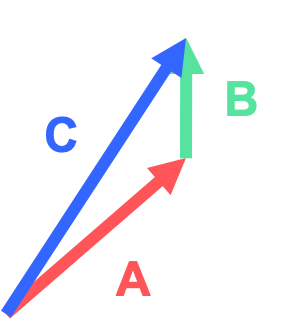
Adding two or more vectors graphically is accomplished by drawing the vectors such that the head (the arrow) of one vector is touching the tail of the next vector, in any order. The net, or resultant vector is found by drawing a line from the tail of the first vector to the head of the last vector.
If we were to add a vector A to a vector B to form a vector C, for example, it would be written as . We would sketch the diagram by first drawing vector A (here it is oriented to the northeast somewhat), and then draw the tail of the vector B (which represents some sort of vertical quantity) starting at the tip/head/arrow of A. Finally we would draw the resultant C vector by sketching a line from the beginning of A to the end of B. This final vector represents the net, or resultant, vector.
To identify the magnitude and direction of the resultant C quantity, there are a number of ways you could determine those values. If solving graphically, you'd take a ruler and a protractor and measure the vector on your drawing.
This type of determination isn't as precise as most people would like, but drawing the sketch and being able to make a rough determination can be useful.
Walking city blocks
If I walk 6 blocks north from my house, and 8 blocks west, where do I end up relative to where I started?
Solution:
2.3.2. Vector Subtraction
How would one go about graphically subtracting one vector from another?
In the same way that A - B is equal to A + (-B), we can take the negative of a vector—a vector of the same magnitude but pointed in the opposite direction—and add it (place it tip-to-tail) with the first vector.
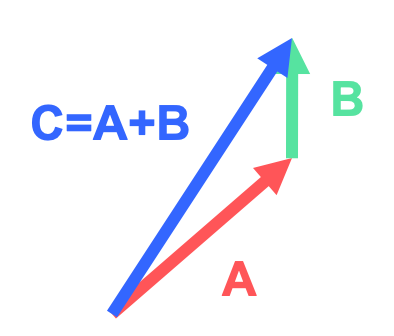
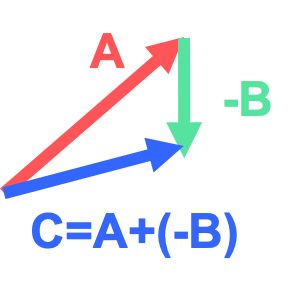
Subtracting vectors
If A = 3.0 m/s North and B = 2.0 m/s East, what is the vector result of A + -B (magnitude & direction)?
Solution:
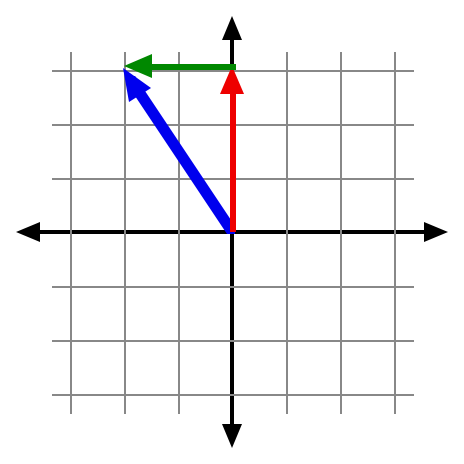
If B = 2.0 m/s East, then -B is in the opposite direction, ie. 2.0 m/s West (to the left). Place the vectors tip-to-tail, draw the resultant from the tail of the first vector to the tip of the last, and measure the resultant vector to get your final answer, both magnitude (3-point-something m/s) and direction (~120°?)
2.2.3. Specifying Direction
When giving the directions for a vector, it's best to be as clear as possible. Just saying "generally northeast" isn't as good as saying "36.9°," where that angle is typically specified relative to the positive-x axis.
Sometimes a problem will specify "20° North of West," and you can use that to figure out what's going on. In specifying your own answers, however, you should stick to using angles based on a unit circle, with 0 on the positive x-axis, and measuring counterclockwise from there. For small angles, it's okay to give answers in negative degrees as well.
Discuss this problem
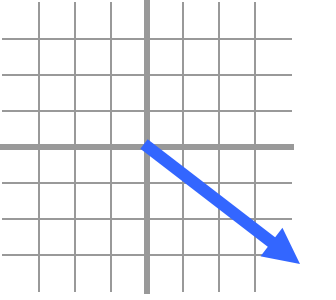
Which direction is the vector pointing in this problem? Which answers are "just okay"? Which answers are the best?
- Southwest
- Southeast
- 36.9°
- -36.9°
- 323°
- 53.1° East of South
Solution:
Answers 2, 4, 5, and 6 are all correct to some extent. The best answers are 4 and 5.
Obviously, graphical addition of vectors is fine for sketches, but measuring the resultant vector with a ruler and protractor isn't very precise when it comes to numeric solutions. For that, we have two slightly more complex, but incredibly useful, systems: the polar-notation system, and the unit-vector system.
2.4. Polar Notation of Vectors
Using polar notation involves describing vectors in terms of their magnitude and direction, as we have already done, eg. 10 m/s @ 36.9°. To be able to perform vector addition we're going to need to be able to split a vector up into its x and y components, which requires using some simple trigonometry.
Vector components
Any vector in a two-dimensional x-y plane can be described in terms of its x and y components, the two vectors along the x and y axes that, when added, produce the original vector.
How, specifically, do we do that?
Splitting a vector into components

Given the vector A and some angle, we can use trigonometry to solve for the horizontal and vertical components of A.
Likewise, given the horizontal and vertical components of A, we can use the Pythagorean theorem and the inverse tan function to convert them to a vector with a magnitude and a direction.
2.4.1. Adding Polar Notation Vectors
Once we're comfortable with the idea of considering a vector in terms of its x-y components, we can take advantage of a powerful fact:
The sum of the vector components in any direction is equal to the resultant component in that direction.
Let's see how that works.
Strategy for adding vectors using polar notation
- Sketch & label vectors
- Find x- and y- components of all vectors
- Add x-components together to get x-component of Resultant. Do the same with the y-components.
- Use Pythagorean theorem to get the Resultant's magnitude
- Use trig to get the Resultant’s direction
The Tortoise's Journey
A tortoise crawls 10m southeast, then 12m at 60° west of south.
- Make a sketch of his journey.
- Find components of each leg of trip
- Calculate components of resultant
- Calculate magnitude & direction of resultant
Solution:
2.5. Unit Vectors (i, j)
Yet another way exists to designate, and calculate with, vectors: unit vectors.
What is a unit vector?
A unit vector is a vector along the x or y axis that has a magnitude of 1.
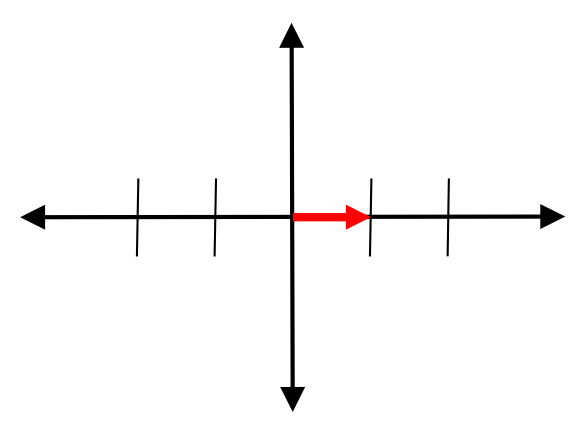
The unit vector in the +x-direction is given the label î, while the +y-direction unit vector is labelled ĵ. The carat ^ over the top of the letter is called a "circumflex," and in this case indicates that this is a unit vector. These unit vectors have a unit that matches whatever unit we’re talking about (meters, m/s, m/s2, etc).
What use is a unit vector?
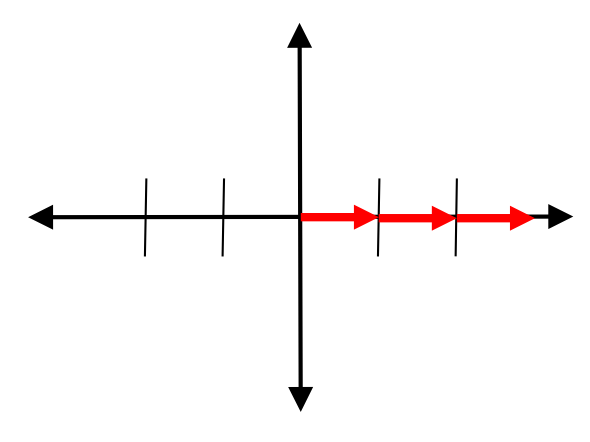
When a vector is multiplied by a scalar quantity, the result is a single vector pointing in the same direction, but with a magnitude = magnitude of the original vector times the value of the scalar.
How is this helpful? If someone is walking at "3 miles per hour in the positive-x direction" we can simply specify their velocity as "3î mph."
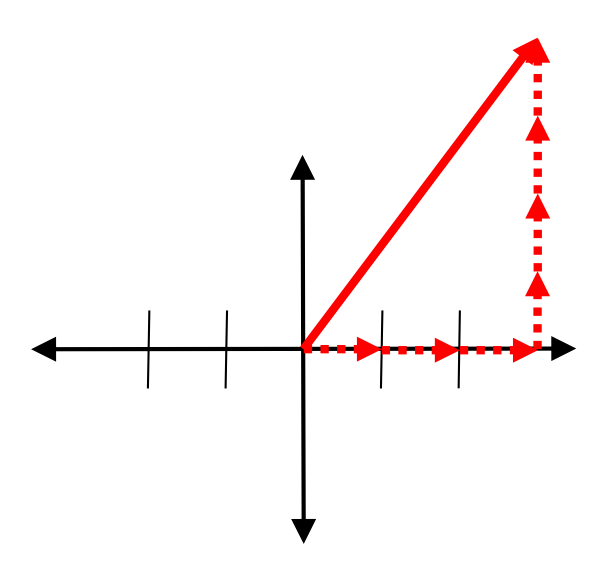
There's not much added value in being able to indicate one-dimensional motion using unit vectors, which is why you may not have learned about them before now. But now that we're working in 2-dimensional or 3-dimensional motion, and now that we know we need to break vectors up into components on a regular basis, it's very convenient to be able to say that something's velocity is "3î + 4ĵ m/s."
You can certainly deduce that the overall (net) velocity of such an object is 5 m/s, and you can calculate tan-1(4 / 3) to identify the direction (angle) as 53.1°. That's important to know.
But if we have to do any analyses that require us breaking this vector up into x and y components, it already has been! The "5 m/s at 53.1°" consists of two components, one in the x direction and one in the y direction. And we can use those components to solve problems.
Expressing vectors in unit-vector notation
Convert each of these polar-notation vectors to unit-vector form.
Now that we know a little about unit vectors, let's try another problem.
The Tortoise's Journey, part 2
A tortoise crawls (7.07î + -7.07ĵ) meters, then (-10.4î + -6.00ĵ) meters.
- Make a sketch of his journey.
- Determine his displacement
Solution:
2.5.1. Derivatives of Unit Vectors (i, j)
We typically use x to indicate a position along the x-axis, and y for the y-position. If we want to indicate a position based on multiple axes coordinates, we often use r to indicate that position.
Indicating position with unit vectors
To indicate a position with unit vectors, use the variable r, as shown here:
This position r would indicate a point in 2-dimensional space at the position (3, 4) relative to the origin.
If you were asked to determine Δx, the displacement between two positions xfinal and xinitial, that wouldn't be difficult to do.
Likewise, determine the displacement between two r-vector positions in space is fairly straightforward.
Calculating Δr
At one point in time, a particle is located at the position
A few moments later, the particle is located at
Calculate Δr for this particle.
Solution:
By considering the x and y components separately—the hat-i and hat-j terms, that is—we can easily solve for the change in position Δr:
If the problem were to ask for the magnitude and direction of this Δr, we'd have to resolve those components into a single resultant with a magnitude and direction. Typically, however, if a problem gives you values in unit-vector notation, you can leave your result in that same form.
Another classic problem is to determine the time-derivative of one of these unit-vector expressions. Consider this problem.
Calculating v as a derivative with unit-vectors
A particle's position in 2-dimensional space is given by the expression
What is the instantaneous velocity of the particle at time t = 4.0 seconds?
Solution:
To find instantaneous velocity v, we can take the time-derivative of the position function:
With this function, then, we can identify the velocity at 4.0 seconds: